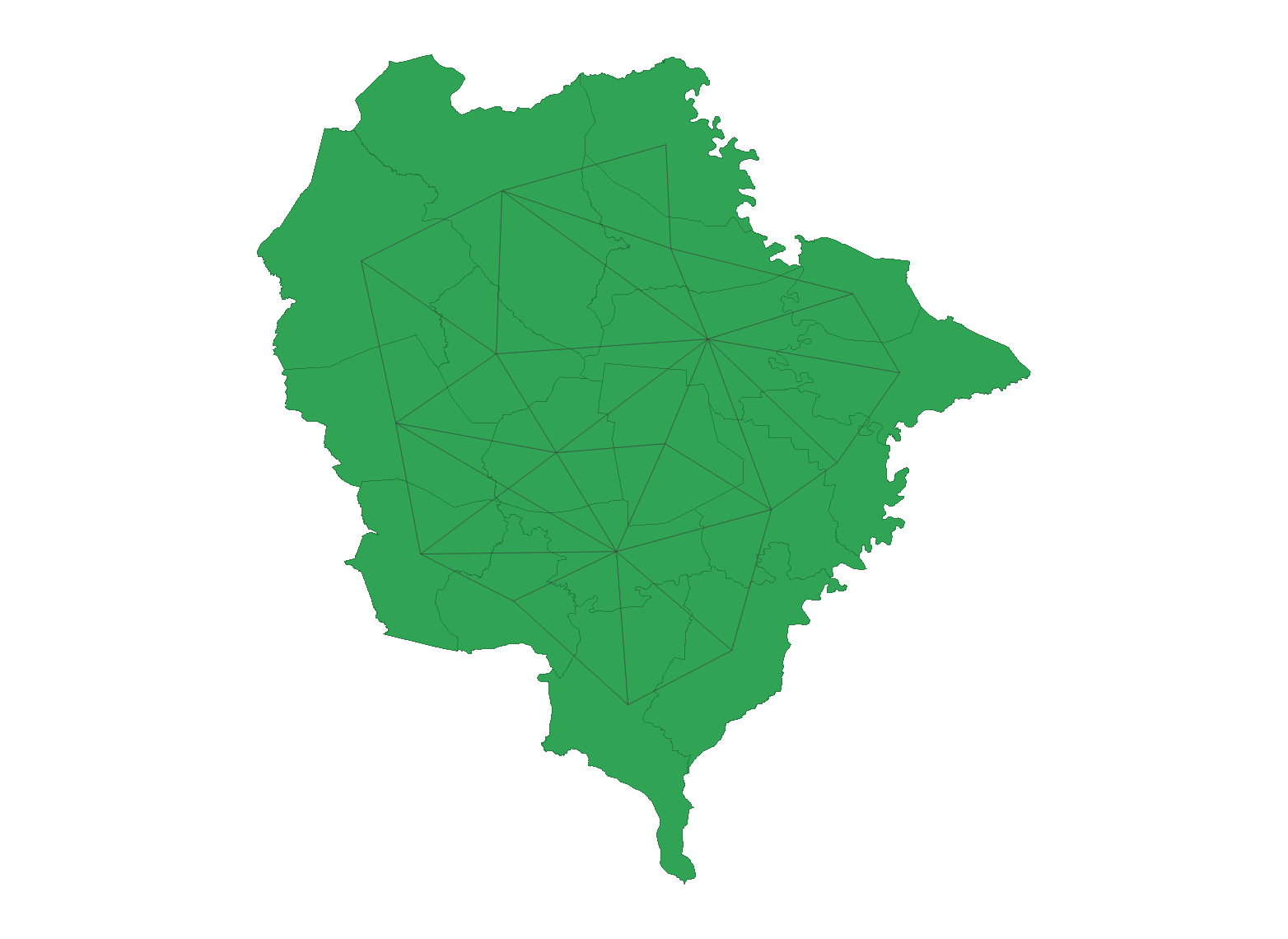Spatial autocorrelation
Spatial autocorrelation.RmdㅤSpatial autocorrelation refers to a clustering pattern in the spatial distribution of a variable, indicating the extent to which a variable is spatially correlated with itself. Positive autocorrelation (or clustering) occurs when neighboring observations are more similar to each other, while negative autocorrelation (or dispersion) occurs when neighboring observations tend to differ. This technique can be divided into two main methods:
Spatial weight
ㅤIn the first step, we identify the spatial weight matrix
as a square binary matrix based on queen contiguity. The concept of
queen contiguity considers adjacent neighbors that mutually share
borders and edges. In this square binary matrix, if units i and j share
a border, the matrix weight
is set to 1; if they do not share a
border,
is set to 0. The diagonal elements of the weight matrix
are also set to 0. In this study, Spatial weight of 18
locations(sub-district) was evaluated and calculated queen contiguity by
using GeoDa (version 1.22) as presented in the figure
below.

Global Spatial Autocorrelation
ㅤA global detection technique was used to assess spatial autocorrelation across the entire study area, providing a single summary measure that describes the overall degree of spatial association in the dataset. The Global Moran’s I statistic (Moran, 1950) was used to calculate the global autocorrelation coefficient. It yields a score ranging between -1 and 1: a positive score indicates clustering of similar values, a negative score indicates dispersion of similar values, and a score close to zero suggests a random spatial distribution.
Global Moran’s I statistic equation is 1:
$$I = \frac{n}{S_0} \cdot \frac{\sum_{i=1}^{n} \sum_{j=1}^{n} w_{ij} (x_i - \bar{x})(x_j - \bar{x})}{\sum_{i=1}^{n} (x_i - \bar{x})^2}$$
Where:
- \(I\) is the Global Moran’s I for observation \(i\).
- \(n\) is the total number of observations.
- \(x_i\) and \(x_j\) are the values of the variable of interest at locations \(i\) and \(j\).
- \(\bar{x}\) is the mean of the variable of interest.
- \(w_{ij}\) is the spatial weight between locations \(i\) and \(j\).
- \(S_0 = \sum_{i=1}^{n} \sum_{j=1}^{n} w_{ij}\)
ㅤInference for Global Moran’s I was based on the null hypothesis of
spatial randomness. The significance of the Global Moran’s I statistic
was evaluated using a permutation test distribution, with 99,999 random
permutations computed using GeoDa (version 1.22).
Local Spatial Autocorrelation
ㅤLocal detection focuses on spatial autocorrelation at specific locations within the study area. The Local Moran’s I statistic was used to calculate local autocorrelation. A positive Local Moran’s I indicates a cluster of similar values, while a negative Local Moran’s I indicates clustering of dissimilar values. If the Local Moran’s I is close to zero, it suggests that there is no significant spatial clustering at that location.
Local Moran’s I statistic equation is 2:
Where:
- \(I_i\) is the Local Moran’s I for observation \(i\).
- \(x_i\) is the value of the variable of interest at location \(i\).
- \(x_j\) is the value of the variable at location \(j\).
- \(\bar{x}\) is the mean of the variable of interest.
- \(w_{ij}\) is the spatial weight between location \(i\) and location \(j\).
- \(\sum_{i=1}^{n} (x_i - \bar{x})^2\) is the total sum of squared deviations from the mean.
ㅤThe significance of the Local Moran’s I statistic for each spatial
unit was evaluated using a permutation test distribution, with 99,999
random permutations computed using GeoDa (version 1.22).
This high number of permutations increases the precision of the
significance tests, ensuring more reliable identification of significant
spatial clusters. Results are considered significant when the p-value is
less than 0.05.
Local Indicators of Spatial Association (LISA)
ㅤLocal Indicators of Spatial Association (LISA), as described by Anselin (1995), are used to identify the magnitude of spatial clustering around specific geographical points or areal units. Each observation reveals the extent of significant spatial clustering of similar values in the vicinity of that location. In this study, LISA was utilized to analyze local spatial autocorrelation, which resulted in four distinct categories2:
- High-High Clusters: Areas where high values cluster with other high values.
- Low-Low Clusters: Areas where low values cluster with other low values.
- High-Low Outliers: Areas with high values surrounded by low values.
- Low-High Outliers: Areas with low values surrounded by high values.
ㅤThis classification helps to understand the spatial distribution of the variable of interest and identify patterns of spatial dependence within the study area.
Moran scatter plot
ㅤThe Moran scatter plot, introduced by Anselin (1996), plots the spatially lagged variable on the y-axis and the original variable on the x-axis. The slope of the linear fit represents Moran’s I. For a variable in deviations from the mean and row-standardized weights where equals the number of observations , Moran’s I simplifies to3:
$$I = \frac{\sum_i \sum_j w_{ij} z_i z_j}{\sum_i z_i^2} = \frac{\sum_i (z_i \times \sum_j w_{ij} z_j)}{\sum_i z_i^2}$$
In this context, the slope of the regression of on represents Moran’s I.
Inference
Null hypothesis
ㅤPermutation inference for Moran’s I relies on a null hypothesis of spatial randomness, with the statistic’s distribution derived either under the assumption of normality (independent normal random variates) or randomization (where each value is equally likely at any location)3.
Pseudo p-value
ㅤThe reference distribution is used to calculate a pseudo p-value as3:
- \(p\) is the pseudo p-value.
- \(R\) is the number of times the computed Moran's I from permuted data is equal to or more extreme than the observed statistic.
- \(M\) is the number of permutations.
Reference
(1) Bivand RS, Wong DW. Comparing implementations of global and local indicators of spatial association. Test. 2018;27(3):716-48.
(2) Anselin L. Local indicators of spatial association—LISA. Geogr Anal. 1995;27(2):93-115
(3) GeoDa Center for Geospatial Analysis and Computation. Global Spatial Autocorrelation (Lab 5A). Available at: https://geodacenter.github.io/workbook/5a_global_auto/lab5a.html. [Accessed 8 September 2024.]